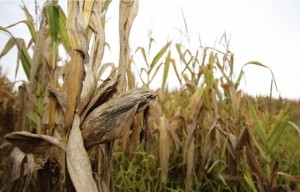Heat pops county's bumper corn crop
By Steve Herring
Published in News on July 30, 2012 1:46 PM

News-Argus/MICHAEL BETTS
The dry husk of an ear of corn in a field along U.S. 70 shows how the heat has affected this year's corn crop.
Although it is still too early to estimate corn yields, Wayne County farmers are saying that July's unrelenting heat wilted expectations of a possible bumper crop -- despite a late spate of thunderstorms that brought as much as five inches of rain to many fields.
"It has all been hurt. The planting date has more of an impact on it than location because everywhere was extremely hot and dry," said field crop agent John Sanderson with the county Extension Service.
The crop's condition is pretty much the same across the county, Sanderson said. Some fields of heavier land, planted early, may hold "pleasant surprises" where yield is concerned, he said. But there is no doubt that much of the potential yield farmers saw in June has dissipated.
"At the end of June, it looked like we had the opportunity to make a bumper crop if we continued to get some rain, and then we had those really high temperatures," Sanderson said. "Those 20 days of 95- and 100-degree weather during that period, it really took a toll on the corn.
"Probably the earlier-planted corn suffered the least. It had already pollinated and gotten by that critical period. It was in the grain fill stage. Most that I have looked at probably lost anywhere from 10 to 30 percent of the yield potential that it had. The later-planted corn that was either pollinated or beginning to pollinate or pollinated during that period, it really has been devastated. Somewhere between 50 and 75 percent of the yield potential is gone."
Cornfields look relatively productive at a distance, he said, because the plants themselves had formed strong stalks before the hot weather hit.
But during the period when the plants needed to make their ears, the heat took its toll and not even late July's rain could make up for it.
"You get in there and the stalks either do not have an ear or, if they do have an ear, it might look normal," he said. "But you shuck it back and then you see it hasn't pollinated, so you don't have much grain there. I believe it will be better than last year, but it still will certainly be below an average crop again this year. I am afraid when we get in there with the combines the grain just isn't going to be there."
Dry weather has devastated the county's corn crop for the past several years and Sanderson said he feels certain that some farmers are looking at alternatives to corn after suffering through the streak of low yields.
One such alternative is grain sorghum -- a direct replacement for corn acreage, Sanderson said.
"I think if this year's grain sorghum crop turns out to be good, more will substitute grain sorghum for corn in their rotation," he said. Sorghum resembles corn in its early stages and its planted later in the season.
Sanderson expects some farmers to begin harvesting corn early because of premium prices that feed mills will likely be paying for corn delivered in August. Some corn could be picked as early as the middle of the month, he said.
"The grain sorghum looks very good now," he said. "Most of it is just starting to head. It looks like we are in a similar situation we were with corn -- the potential to have a very good grain sorghum crop. It is a little more tolerant to the heat than corn is, and certainly more tolerant to dry weather.
"So if we continue to get a little bit of rain, I think we will have a very good sorghum crop."
Planting started in May and some farmers may still be planting, he said. Harvesting normally begins in early September and could continue to November, he said.
"Tobacco, I guess, has come through this hot weather very well," Sanderson said. "We had a very variable tobacco crop this year. It got off to kind of a slow start, a tough start. These recent rains that we have had, the heat wave broke, and tobacco has kind of come along.
"Right now, barring any hail or hurricanes or bad thunderstorms, I think we are looking at an average to slightly below-average tobacco crop this year."
The county's average yield is approximately 2,200 pounds per acre.
"Cotton looks good and has come through the heat wave very well," he said.
There is still a long way to go, but the potential is for a good cotton yield with "a little bit of cooperation from Mother Nature," he said.
